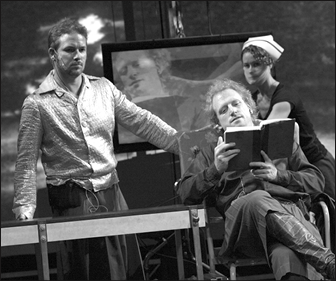By Wickham Boyle
Hamlet
Directed by Elizabeth LeCompte
A Wooster Group production
Through Dec. 2
The Public Theater
(212-967-7555; publictheater.org)
How many times have you seen “Hamlet”? I have seen “Hamlet” as a woman, played by Diane Venora. I have seen “Hamlet” in an abandoned schoolhouse, where you had to run from room to room choosing which scene you wanted to see. (So Hamlet might be giving his “to be or not to be” soliloquy, while on another floor, Ophelia was drowning herself in the bath.) I have watched a Zulu “Hamlet,” one in Leningrad, Oslo and in Rome, but the Wooster Group’s deconstruction of Shakespeare’s most verbose play, now at the Public Theater, is one that really makes a definitive statement about the importance of experimental work.
When I worked as the Executive Director of LaMama after graduating from Business School, many of my classmates who were running Morgan Stanley or consulting to oil companies asked me at reunions, “What exactly is experimental theater?” And the tag line I used as both a quick take and humorous banter was this: “Suppose you take ‘Hamlet,’ and throw all the pages of the play down the stairs. Then you do the play in the order that the pages land. By that action, you disconnect the audience from what they are expecting and open them up to their imaginations and to the inner workings of the play.” It was intentionally glib, and overly broad, and yet that is the essence of experimentation.
Liz LeCompte, the 63-year-old, longtime director of the Wooster Group, is never glib; she is a hard-core priestess of experimentalism. LeCompte has lived and breathed a nearly cult-like commitment to experimental interpretations of classic works, and in her zeal has evolved into a quasi-Messiah of the genre. As an example, when LeCompte received her $350,000 MacArthur “genius” award in 1995, she gave the money to the troupe and when questioned about this high-minded act she responded, “I am not an intellectual. I am not trying to mean anything — I’m trying to have a good time.”
LeCompte and the Wooster Group still work out of a tiny, throwback space at 33 Wooster Street in Soho. The core company consists of 17 actors, technicians and designers. Occasionally the Group takes on associates, and for this new “Hamlet” they have folded in Casey Spooner, of the electro-clash band Fisherspooner. He plays and sings Laertes, and portrays both Rosencrantz and Guildenstern.
Even with this detail of casting one begins to imagine how different this “Hamlet” is. In fact, it is has been said about LeCompte’s style that she takes something you think you knew every nook and cranny of, and deconstructs it so that you, the audience, can return to it refreshed, excited and illuminated by seeing the familiar turned on its head. So how did she do this to “Hamlet”?
The stage is set with numerous video and film screens that all move on rollers. There are video cameras that flash close-ups of the live action as the large screens show nearly continuous projections of the famed 1964 Broadway production of Hamlet starring Richard Burton. That play was filmed from 17 different camera angles and shown for only two days in movie houses across America. It was an innovative idea back in that day, and one that was heralded as possible through “the miracle of Electronvision.”
In her notes on “Hamlet” LeCompte says, “Our ‘Hamlet’ attempts to reverse the process, reconstructing a hypothetical theater piece from fragmentary evidence of the edited (1964) film, like an archeologist inferring a temple from a collection of ruins.” The original film has been digitally altered and sped up. Some characters are totally blurred out while at other times the actors on the stage enact a perfect parody of the filmed action.
The costumes, which are mostly gray, black and white with occasional touches of red, allow the actors to mesh and meld with the filmed images, creating ghostly connections. In the scene when Hamlet’s father appears as a ghost, the specter is only represented on film and the live actors react to him and not a live or modern representation.
The actors are remarkable not only for their portrayals, but for the way they interface with massive technology. Players yell “fast forward” and the film races as the actors scurry, moving to the next scene. It is like “Hamlet” on speed and perhaps it speaks to the effect that technology has on all of us as we race to keep up with the quick time that machines have afforded us.
LeCompte describes herself as “a classic voyeur. I love to watch. I love getting people on stage doing what I wanted. I watch them for something that preceded the words, for a physical metaphor for where the words come from.”
You too will be watching, unable to turn away.

































